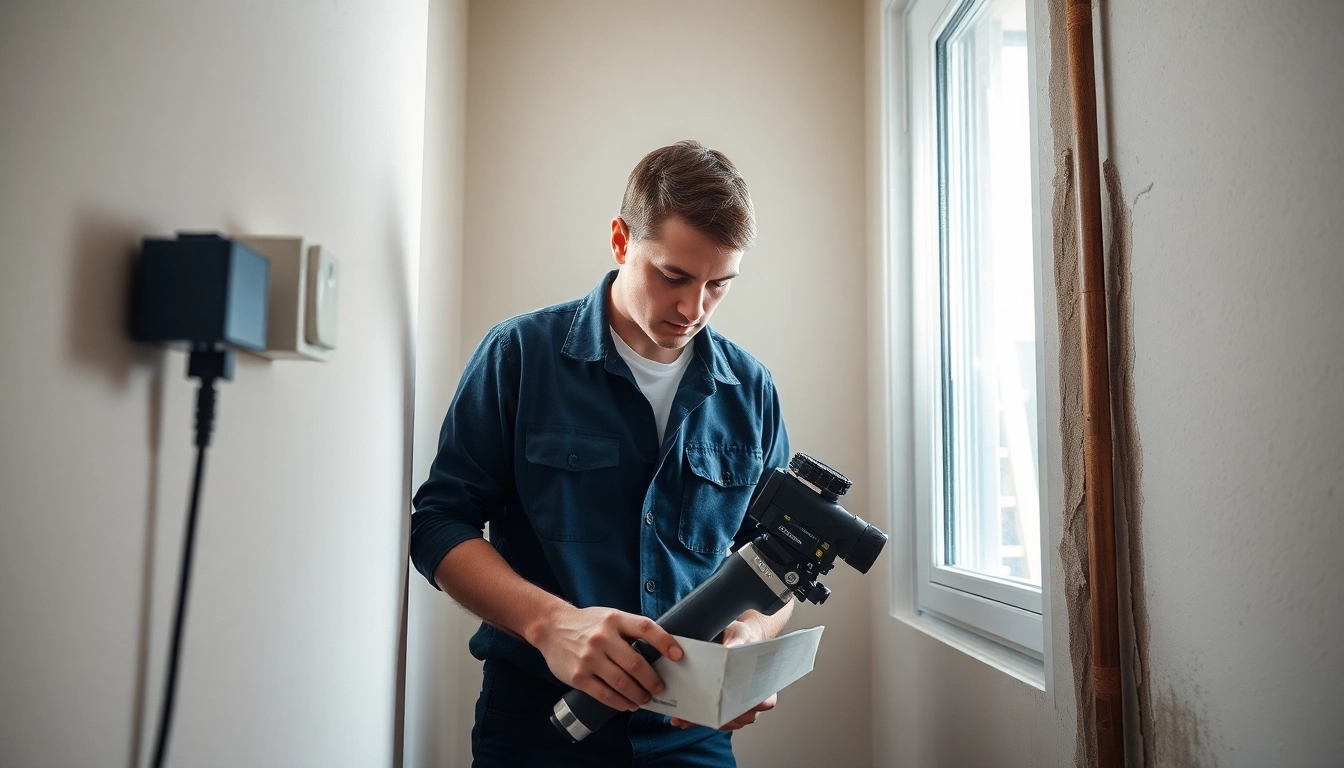Understanding Leak Detection Cornwall Methods
Leaks in any property can lead to significant structural damage and financial loss. In Cornwall, understanding the various leak detection methods is crucial for homeowners and business owners alike. The term Leak Detection Cornwall encompasses several strategies, each tailored to identify water leaks effectively and efficiently. In this section, we will delve into the most common methods of leak detection, the benefits of hiring professionals, and the tools that are typically employed.
Overview of Leak Detection Techniques
Leak detection is the process of identifying leaks within a system, particularly in plumbing, roofs, and other structures where water loss can occur. The primary leak detection techniques include:
- Visual Inspection: This basic method requires a careful check for signs of water damage such as stained walls, wet spots, or mold growth. Visual inspections can often identify obvious leaks but may miss hidden ones.
- Infrared Thermography: This technique uses thermal imaging cameras to detect variations in temperature that may indicate moisture accumulation, thus pinpointing leak locations without invasive measures.
- Ashrae Leak Detection: Employing tracer gas (like hydrogen or helium) introduced into the plumbing system, technicians can identify leaks by measuring where the gas escapes.
- Acoustic Leak Detection: Utilizing sensitive microphones and sound detectors, this method picks up the noise of water escaping from plumbing systems.
- Moisture Meters: These devices measure the moisture content in walls and floors, providing a quantitative method to identify leaks.
Benefits of Professional Leak Detection
Hiring professionals for leak detection offers numerous advantages:
- Expertise: Professionals have specialized training to identify leaks accurately and quickly using the latest technology.
- Non-destructive methods: Modern techniques are non-invasive, minimizing potential damage to property.
- Time efficiency: Professionals can typically diagnose issues faster than a DIY approach, allowing for timely repairs.
- Comprehensive Solutions: Alongside detection, professionals can often provide repair services, eliminating the complication of sourcing multiple contractors.
Common Tools Used in Leak Detection
Several key tools are essential for effective leak detection:
- Thermal Imaging Cameras: Used to detect temperature differences in surfaces that indicate leaks.
- Ultrasonic Leak Detectors: These listen for sounds associated with leaks that may not be audible to the human ear.
- Moisture Meters: Designed to measure the moisture level in various materials, helping to identify areas of water intrusion.
- Smoke Tests: Creating a colored smoke to visualize airflow, this method can show where leaks might be present in ductwork.
Identifying Signs of Leaks in Cornwall Properties
Identifying leaks early can save homeowners substantial time and money in repairs. It’s vital to be aware of the common signs that may indicate a leak within your property. This section explores the typical indicators, including visible water damage, unusual water bills, and auditory clues.
Visible Water Damage Indicators
When checking for leaks, visible signs of water damage are often the first indicator. Common signs include:
- Discoloration on Walls or Ceilings: Brown stains can signal leaks from above.
- Peeling Paint or Wallpaper: Moisture trapped under surfaces can cause paint or wallpaper to bubble and peel.
- Mold Growth: The presence of mold in hidden areas indicates prolonged moisture exposure.
- Puddles or Damp Spots: Any water pooling near plumbing fixtures or appliances should be immediately addressed.
Unusual Water Bills and Their Implications
Unexpected surges in water bills can be a significant indicator of leaks. Homeowners should monitor their water usage and investigate discrepancies. If bills suddenly increase without a corresponding increase in water use, a leak is likely present. This can be further confirmed by:
- Comparing monthly water usage over time to identify unusual spikes.
- Using a water meter to check for water flow when all appliances and fixtures are turned off.
- Inspecting irrigation systems and outdoor faucets, as these are common sources of leaks.
Auditory Signs of Leaks
Sometimes, leaks can be detected through sound. Common auditory signs include:
- Dripping Sounds: Pooled water from leaks often produces a dripping noise, especially in basements and under sinks.
- Running Water Sounds: If you hear water running but no fixtures are in use, it could signal a leak in the plumbing.
- Hissing or Bubbling Noises: These sounds might indicate air escaping from pipes, suggesting a break in the plumbing.
Implementing Preventative Measures for Leak Detection Cornwall
Proactive measures are essential for preventing leaks and ensuring that your property in Cornwall remains safe from water damage. In this section, we will discuss the importance of regular plumbing inspections, upgrading old plumbing systems, and utilizing smart technology for monitoring leaks.
Regular Plumbing Inspections
Scheduling regular plumbing inspections provides an opportunity to identify potential issues before they develop into major problems. Homeowners should consider the following approaches:
- Annual Inspections: Routine checks by a certified plumbing professional can reveal early signs of wear and deterioration.
- Self-Inspections: Homeowners can learn to identify potential issues like rusty pipes or faulty fittings by performing regular checks.
- Seasonal Maintenance: Specific checks should be done seasonally, especially before winter when pipes are at risk of freezing and bursting.
Upgrading Old Plumbing Systems
If your property has outdated plumbing fixtures or piping, consider upgrading to modern materials that are less prone to leaks. Replacement options include:
- PVC or PEX Pipes: These materials are more resilient and flexible than traditional metal pipes, reducing the risk of cracking.
- Low-Flow Fixtures: Installing water-efficient fixtures can minimize water wastage, reducing the stress on plumbing systems.
Utilizing Smart Tech for Leak Monitoring
Advancements in technology have made it possible for property owners to monitor leaks more effectively:
- Smart Water Sensors: These devices alert homeowners to leaks and moisture levels, allowing for real-time monitoring.
- Smart Water Meters: By monitoring consumption patterns, these devices help identify unusual spikes that may indicate a leak.
- Automated Shut-off Valves: These smart devices can automatically shut off the water supply in the event of a detected leak, preventing extensive damage.
Emergency Procedures for Leak Detection Cornwall
In the event of a suspected leak, prompt action is critical in minimizing damage. This section offers guidance on immediate steps to take, how to control water damage, and the necessary contact details for emergency services.
Immediate Steps to Take When a Leak is Detected
Upon confirming a leak, property owners should take these immediate actions:
- Turn Off the Water Supply: Locate the main stop valve and shut it off to prevent further water flow.
- Drain Remaining Water: Open faucets to drain residual water from pipes, minimizing pressure and potential bursts.
- Contain the Area: Use buckets or towels to collect dripping water and prevent water from spreading.
How to Control Water Damage
After addressing the leak, controlling water damage requires swift action:
- Remove Standing Water: Use mops, towels, or a wet vacuum to remove any puddles.
- Dry Affected Areas: Use fans and dehumidifiers to circulate air and reduce humidity levels.
- Restore Normal Conditions: Open windows and doors (if conditions permit) to aid in the drying process.
Contacting Emergency Leak Services in Cornwall
While DIY steps are crucial, professional help may be needed for significant leaks. Emergency leak services in Cornwall can be contacted as follows:
- Identify local leak detection specialists by searching online or utilizing community resources.
- Ensure that the company is licensed, insured, and experienced in handling emergency situations.
- Communicate the nature of the leak and any steps already taken to mitigate damage for a faster response.
Cost Factors and ROI of Leak Detection Cornwall
Understanding the financial implications of leak detection and water damage prevention is essential for property owners in Cornwall. This section explores the typical cost structures and potential savings associated with early leak detection.
Understanding Pricing Structures for Services
Leak detection services generally follow several pricing models, including:
- Flat Fees: Some companies may charge a flat fee for conducting inspections or hour-based services.
- Emergency Service Fees: Higher fees may apply for emergency call-outs, especially outside regular business hours.
- Repair Costs: Beyond detection, the costs to repair leaks can vary widely based on the extent of the damage and necessary repairs.
Potential Savings from Early Leak Detection
Investing in leak detection can yield substantial savings:
- Lower Water Bills: Early detection can prevent wastage and avoid sharp increases in water usage costs.
- Reduced Repair Costs: Identifying leaks early can minimize extensive damage, potentially saving thousands in structural repairs.
- Insurance Premiums: Proactive maintenance, including regular inspections, can help maintain lower insurance premiums by reducing risk.
Evaluating Long-Term Benefits
The long-term benefits of investing in leak detection services extend beyond immediate financial savings:
- Increased Property Value: Properties maintained with attention to plumbing issues often see higher resale values.
- Health and Safety: Addressing leaks prevents mold growth and other hazards, protecting inhabitants’ health.
- Peace of Mind: Knowing that a property is in good condition offers homeowners greater peace of mind, especially during adverse weather conditions.



